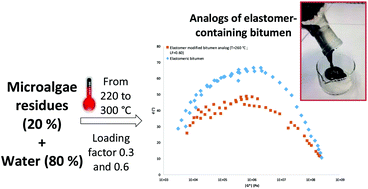Ask for a reprint
email :
* Give your email
2018
ACL
|
Ilef Borghol, Clémence Queffelec, Patricia Bolle, Julie Descamps, Christophe Lombard, Olivier Lepine, Delphine Kucma, Chantal Lorentz, Dorothée Laurenti, Valérie Montouillout, Emmanuel Chailleux, Bruno Bujoli, 'Biosourced analogs of elastomer modified bitumen through hydrothermal liquefaction of Spirulina Sp. microalgae residues', Green Chemistry 20 2337-2344 (2018) doi:10.1039/c8gc00094h
The hydrothermal liquefaction of Spirulina sp. microalgae (i.e. cyanobacteria) byproducts was investigated for the production of road binders from renewable sources. In the 220-300 °C temperature range, a water-insoluble viscous material was obtained in a ca. 50% yield, which consisted of an oily fatty acid-based fraction mixed with organic and inorganic solid residues (ca. 20%). More interestingly, this material exhibited viscoelastic properties similar to elastomer-containing bitumen, when operating the hydrothermal liquefaction between 240 and 260 °C. This is the first example of a bio-sourced product showing such properties. At higher temperature, fragmentation of species of high molecular weight occurred, resulting in less viscous materials that were no more thermorheologically simple. The reactor filling ratio was also allowed to vary (i.e. 30 % versus 60%), showing very little influence in terms of yield and viscoelastic properties of the resulting bio-binders.
|

|